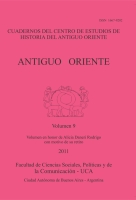Please use this identifier to cite or link to this item:
https://repositorio.uca.edu.ar/handle/123456789/7456| Título: | Manetho's Twenty-third Dynasty and the legitimization of kushite rule over Egypt La Dinastía XXIII de Manetón y la legitimación del gobierno kushita sobre Egipto |
Autor: | Adams, Mathew J. | Palabras clave: | HISTORIA ANTIGUA; HISTORIA DE EGIPTO; MANETON; GENEALOGIA; DINASTIAS; CIVILIZACION KUSHITA | Fecha de publicación: | 2011 | Editorial: | Pontificia Universidad Católica Argentina. Facultad de Ciencias Sociales, Políticas y de la Comunicación. Departamento de Historia. Centro de Estudios de Historia del Antiguo Oriente | Cita: | Adams, M. J. Manetho's Twenty-third Dynasty and the legitimization of kushite rule over Egypt [en línea]. Antiguo Oriente: Cuadernos del Centro de Estudios de Historia del Antiguo Oriente. 2011, 9 Disponible en: https://repositorio.uca.edu.ar/handle/123456789/7456 | Resumen: | Resumen: Este artículo considera la identificación de los reyes en los epitomes de la Dinastía XIII de Manetón, y su función en las tradiciones historiográficas del antiguo Egipto. A pesar del rechazo de larga data de la Dinastía XXIII de Manetón como ahistórica, aquí se argumenta que los nombres preservados en la Dinastía XIII son parte de una auténtica tradición historiografíca originada con el rey kushita Taharka. El artículo va aún más allá para sugerir razones específicas de por qué la Dinastía XIII fue integrada con otras tradiciones de listas reales, así como una reconstrucción histórica de tal proceso. Más aún, éste análisis identifica funciones específicas para los nombres que aún no han sido identificados, Psammus y Zet, en la versión de Julio Africano del epitome de Manetón. El argumento considera la perspectiva política y cultural de los reyes kushitas que eran responsables de una rama de la tradición de la lista de reyes y ofrece algunas interpretaciones de las prácticas reales kushitas a la luz de estas conclusiones. Abstract: This paper considers the identification of the kings in the epitomes of Manetho’s Twenty-third Dynasty and their function in the historiographical traditions of ancient Egypt. Despite the long-standing rejection of Manetho’s Twenty-third Dynasty as ahistorical, it is here argued that the names preserved in the Twenty-third Dynasty are part of an authentic historiographical tradition originating with the Kushite king, Taharka. The paper goes further to suggest specific reasons why, and an historical reconstruction of the process whereby, the Twenty-third Dynasty became integrated with other king-list traditions. Additionally, it identifies specific functions for the asyet unidentified names Psammous and Zet in Julius Africanus’ version of the epitome of Manetho. The argument considers the political and cultural perspective of the Kushite kings who were responsible for a strand of king-list tradition and offers some interpretations of Kushite royal practices in light of these conclusions. |
URI: | https://repositorio.uca.edu.ar/handle/123456789/7456 | ISSN: | 1667-9202 | Disciplina: | HISTORIA | Derechos: | Acceso Abierto | Fuente: | Antiguo Oriente: Cuadernos del Centro de Estudios de Historia del Antiguo Oriente. 2011, 9 |
| Appears in Collections: | AO - 2011 vol. 9 |
Files in This Item:
| File | Description | Size | Format | |
|---|---|---|---|---|
| manetho-twenty-third-dynasty-egypt.pdf | 236,91 kB | Adobe PDF |  View/Open |
Page view(s)
363
checked on Apr 30, 2024
Download(s)
382
checked on Apr 30, 2024
Google ScholarTM
Check
This item is licensed under a Creative Commons License

